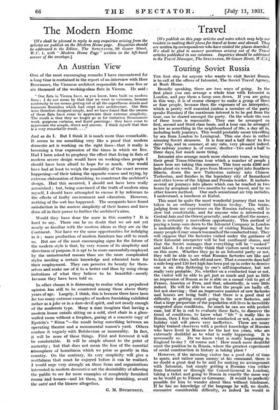The Modern Home
[TV e shall be pleased to reply to any enquiries arising from the articles we publish on the Modern Home page. Enquiries should lie addressed to the Editor, The SPECTATOR, 99 Gower Street, W.C. 1, with "Modern HOW Page" written in the left-hand corner of the envelope.]
An Austrian View
ONE of the most encouraging remarks I have encountered for a long time is contained in the report of an interview with Herr Rosenauer, the Viennese architect responsible for some five or six thousand of the working-class flats in Vienna. He said :
"Our flats in Vienna have, as you know, been built on modern lines I do not mean by that that we went to extremes, because modernity to me means getting rid of all the superfluous details and insincere flourishes which had crept into architecture. Our flats were therefore designed simply, and we have found that the owners of these flats have come to appreciate their extreme simplicity. The result is that they no longer go in for imitation Renaissance work, gorgeous curtains, and florid paintings : they have come to appreciate the simple, direct and sincere. I think myself that that is s very remarkable result. . . ."
And so do I. But I think it is much more than remarkable. It seems to me something very like a proof that modem
domestic art is working on the right lines—that it really is becoming a true expression of the times in which we live. Had I been asked to prophesy the effect that living in flats of modern severe design would have on working-class people I should have been afraid to hope for so much. One would have had at least to weigh the possibility of the exact reverse happening—of their taking the opposite course and trying, by extreme elaboration of furnishing, to counteract the architect's design. Had this occurred, I should not have been really astonished ; but, being convinced of the truth of modem aims myself, I should have attempted to excuse it by reference to the effects of faulty environment and education. However, nothing of the sort has happened. The occupants have found satisfaction in the austere simplicity of their homes and have done all in their power to further the architect's aims.
Would they have done the same in this country ? It is
hard to say. There can be no doubt that we are not yet nearly so familiar with the modern idiom as they arc on the
Continent. Nor have we the same opportunities for indulging in it ; mass production of modern furniture has still to reach us. But one of the most encouraging signs for the future of the modern style is that, by very reason of its simplicity and directness of purpose, it is apt to be more successfully employed by the uninstructed masses than are the more complicated styles needing a certain knowledge and educated taste for their employment. They can perceive its beauty for them- selves and make use of it to a better end than by using cheap imitations of what they believe to be beautiful—merely because they have been told so.
In other classes it is distressing to realize what a prejudiced opinion has still_ to be countered among those above thirty years of age. Largely, I think, this is because there have been
far too many extreme examples of modern furnishing exhibited rather as a joke or in a dare-devil spirit, and not nearly enough of the moderate type. Many a man imagines that having a modem house entails sitting on a cold, steel (their in a glass- walled room without a fireplace, gazing at a concrete e-opy of
Epstein's "Rims "—the result being something between an operating theatre and a monumental mason's yard. Others confuse it vaguely with Bolshevism or immorality. In fact, it will be none of these things. First and foremost it will be comfortable. It will be simple almost to the point of austerity ; but that does not mean the loss of the essential atmosphere of homeliness which we prize so greatly in this country. On the contrary, its very simplicity will give a -restfelnees that must be enjoyed before it can be realized.
would urge very strongly on those firms and organizations interested in modern decorative art the desirability of allowing the public to see far more examples of completely furnished room/ and houses—and let them, in their famishing, avoid the outré and the bizarre altogether.
G. M. Boum:ninny,.


































 Previous page
Previous page